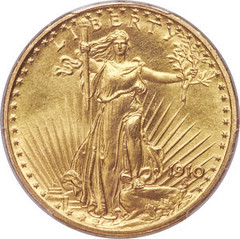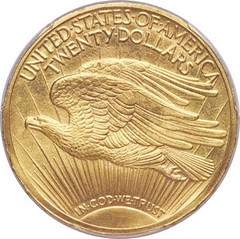
PREV ARTICLE
NEXT ARTICLE
FULL ISSUE
PREV FULL ISSUE
1910 EXPERIMENTAL FINISH DOUBLE EAGLEThis article comes from the July 14, 2020 Coin News email from Heritage Auctions. -Editor 

The United States Mint struggled to find a popular finish for gold proof coins throughout the early 20th century Renaissance of American coinage that Roger W. Burdette has so thoroughly chronicled in his popular writings. Various types of sandblast and satin finishes were adopted at different times, and even more experimental finishes were briefly tinkered with, but none were found that addressed both the technical needs of the coiners and the aesthetic sensibilities of the collectors. Many issues with experimental finishes have vanished without a trace, as the Mint did not carefully document all their endeavors in this regard, as long as the bullion accounts balanced. Experimental pieces that were not adopted for coinage were usually melted for recoinage and forgotten. Fortunately, some extremely rare experimental pieces have survived to give us a glimpse of this colorful, "behind the scenes" era in Mint history. The coin offered in our August 3-9 Signature auction is an exciting new find with a unique experimental finish, an example of an attractive coinage that was not adopted, leaving us with this single amazing example of "what might have been." Heritage Auctions is privileged to present this PCGS SP66+ 1910 Saint-Gaudens double eagle, with its unique experimental finish, in this important offering. Although Augustus Saint-Gaudens' iconic design for the double eagle has often been called America's most beautiful coinage design, the new motifs posed many technical problems for the U.S. Mint's coiners. Even after the high relief of the initial design was lowered to allow high-speed production of business-strike coins, the basined fields and sculptural relief of the devices made it impossible to polish the dies to achieve the brilliant finish collectors prized on proof issues. Accordingly, the Mint switched to a dull matte, or sandblast, finish for proof coins in 1908, similar to that used on many medals of the period. Unfortunately, contemporary collectors failed to appreciate the artistic qualities of the matte format and sales of proof sets declined dramatically. To address this customer dissatisfaction, the Mint switched finishes again in 1909, to the Roman, or satin, finish for gold proofs. In his Saint-Gaudens Double Eagles as Illustrated by the Phillip H. Morse and Steven Duckor Collections, Roger W. Burdette explains the satin finish proofs were simply carefully selected planchets struck with high pressure on the medal press to fully bring up the design and carefully handled to preserve surface quality. The only difference between the two finishes was the matte proofs were sandblasted after striking and the satin proofs were not. The satin proofs are brighter than the matte proofs and usually have a lighter color. Experimentation with the matte finish continued in 1909, as well, as illustrated by the matte proof Indian half eagle that surfaced in lot 1004 of the Gaston DiBello Collection. The 1909 Indian eagle in lot 1177 of the DiBello catalog was also a matte proof experimental piece. Unfortunately, collectors still preferred the old brilliant proofs of earlier years, and sales of proof sets continued to languish. With no good alternatives to fix the problem, the Mint continued to use the satin finish on gold proofs in 1910. Influential gold collector (and future Secretary of the Treasury) William H. Woodin was particularly unhappy with the satin proofs. Woodin went on to specifically request having two 1910 gold proof sets made up, using the matte finish, which he would purchase for his collection. He continued to lobby for a return to the matte finish in an August 19, 1910-dated letter to Assistant Secretary of the Treasury A. Piatt Andrew saying, "The present proofs [1909, 1910] of the St. Gaudens and Pratt designs are simply rotten." Andrew replied that he could not use Mint resources to produce "particular issues" for "particular people", but he agreed to return to the sandblast finish for proofs in 1911 if a consensus of American coin collectors favored that. Accordingly, Woodin posed the question to attendees of the 1910 ANA Convention, displaying a 1908 sandblast proof set next to a 1909 set with a satin finish and asking the members to vote on which was better. The members ruled in favor of the sandblast finish and a resolution was forwarded to Andrew, who ordered a return to the matte finish for proofs, effective the following year. Although Andrew refused to produce sandblast proofs as delicacies for favored collectors in 1910, the Mint apparently experimented extensively with different proof finishes that year for their own purposes. At least one gold proof set with a matte finish has been certified by NGC, exactly the kind of set Woodin requested. The set surfaced in North Carolina in 2005 and the coins were offered individually by Heritage Auctions in 2007. This set might have been produced late in the year, as a trial run for producing sandblast proofs in 1911. The present coin represents an entirely different direction in the search for a popular finish for gold proof coins. The surfaces of this coin are lighter and more reflective than the satin finish proofs, and much brighter than their matte proof contemporaries. John Dannreuther notes the surfaces are: "Full of die polish. My guess is that they maybe were trying to polish the dies and see if they could make a brilliant proof. Just a guess, as the 1910 ANA held that survey and the Sandblast Proofs won the vote over the Satin Proofs! PCGS felt it was different enough to warrant a separate number, as it is not a grainy Satin Proof nor one of the reticulated surfaces Satin Proofs. We don't have records of their experiments in a lot of cases, of which this is one, in my opinion (and that of PCGS). It came in after I finished my book or I would have noted it, of course." Perhaps the experimental issue this coin most closely resembles is the PR67 NGC 1907 Rolled Edge Indian eagle offered in lot 5238 of the FUN Signature (Heritage, 1/2011), which realized $2,185,000. That coin originally belonged to Mint Director Frank Leach and many collectors believe it was a trial piece. The present coin exhibits bright, virtually flawless orange-gold surfaces with brilliant satiny luster, much like Leach's satin proof Rolled Edge ten in the FUN auction. The surfaces of both coins show heavy die polish lines on both sides, a distinguishing feature that separates them from their satin proof counterparts. This Plus-graded Premium Gem Special Strike displays razor-sharp definition on the design elements, with individually countable columns in the Capitol and intricate detail in Liberty's facial features and the eagle's feathers. Only the slightest hint of softness is evident on the four stars below the Capitol. A partial wire edge is visible on both sides of the coin and the inner rim is sharply delineated, with marked concavity in the fields as they fall gracefully away from the rims. The overall presentation is simply stunning. This incredible unique coin possesses an aura of mystery all its own to go with its unparalleled absolute rarity, high technical quality, and terrific eye appeal. We believe it is one of the most important recent discoveries in 20th century American numismatics. Wayne Homren, Editor The Numismatic Bibliomania Society is a non-profit organization promoting numismatic literature. See our web site at coinbooks.org. To submit items for publication in The E-Sylum, write to the Editor at this address: whomren@gmail.com To subscribe go to: https://my.binhost.com/lists/listinfo/esylum All Rights Reserved. NBS Home Page Contact the NBS webmaster 
|